

Most ebook files are in PDF format, so you can easily read them using various software such as Foxit Reader or directly on the Google Chrome browser.
Some ebook files are released by publishers in other formats such as .awz, .mobi, .epub, .fb2, etc. You may need to install specific software to read these formats on mobile/PC, such as Calibre.
Please read the tutorial at this link: https://ebookbell.com/faq
We offer FREE conversion to the popular formats you request; however, this may take some time. Therefore, right after payment, please email us, and we will try to provide the service as quickly as possible.
For some exceptional file formats or broken links (if any), please refrain from opening any disputes. Instead, email us first, and we will try to assist within a maximum of 6 hours.
EbookBell Team

4.8
44 reviewsAs British and Irish migrants sought new lives in the Caribbean, Asia, North America and Australasia, they left a trail of physical remains where settlement occurred. Between the 17th and 20th centuries, gravestones and elaborate epitaphs documented identity and attachment to their old and new worlds. This book expands upon earlier examination of cultural imperialism to reveal how individuals, kinship groups and occupational connections identified with place and space over time.
With analyses based on gravestones and memorial markers in the UK and Ireland, Australasia, Asia, Africa and the Americas, the contributors explore how this evidence can inform 21st-century ideas about the attachments that British and Irish migrants had to ‘home’ – in both life and death.
The book explores aspects of sociolinguistic difference evident in death markers and offers some insights into how growing literacy amongst migrant communities shaped the form of grave epitaphs. It expands upon earlier analyses of cultural imperialism to see how individual families and kinship groups identified with place and space over time and discusses how post-medieval archaeology from a range of death landscapes highlight difference rather than uniformity – including influences by Dutch, Jewish, Muslim and non-religious norms upon memorialisation practices.
It also reveals how women and children, often marginalised voices in imperial scholarship, were as likely to be provided with more elaborate death markers than their male counterparts and challenges ideas of chain migration by demonstrating that families often moved to different, rather than similar, destinations overseas